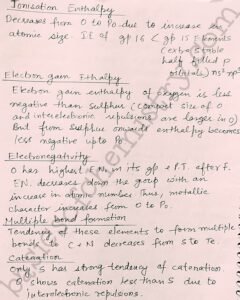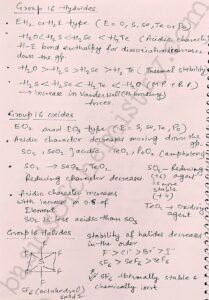Group 16 elements P block elements Properties
Notes on Group 16 Elements p block elements
Here is the explanation of the notes 👇
Properties of group 16 elements p block elements class 12
Group 16 elements are called as chalcogens which means ore forming. Most of the copper minerals contain any of the group 16 elements.
Occurrence
Oxygen is the most abundant of all the elements on the earth which constitutes about 46.6 % by mass of Earth’s crust and also are major constituent of silicate minerals. Oxygen occurs in the free form as O2 and constitutes 20.9 5% by volume of the atmosphere.
Sulphur is the 16 most abundant element found in the earth crust which constitutes 0.03 – 0.1 % by mass. Sulphur is found in galena, zinc blende, copper pyrites and sulphate ores.
Atomic properties of group 16 elements p block elements
Electronic configuration of group 16 elements is ns2 np4.
Atomic radii of group 16 elements is smaller than group 15 elements in their respective periods. Atomic and ionic radii increases down the group due to the increase in the number of the shells.
Ionization energy of the elements of group 16 is lower than group 15 elements in their respective periods because of the extra stability of half filled P orbitals of group 15 elements. Ionization energy decreases from oxygen to polonium due to increase in atomic radii.
Electron gain enthalpy of oxygen is less negative than sulphur due to the compact size of oxygen atom in the group 16 elements. Electron gain enthalpy becomes less negative up to polonium from sulphur onwards.
Electronegativity decreases down the group with the increase in atomic radius. Oxygen has the highest electronegativity in the periodic table after fluorine.
Multiple bond formation decreases down the group from sulphur to till tellurium.
Catenation is the self linking property of the the atom sulphur shows the highest tendency of catenation among group 16 elements. Due to the small size of oxygen atom it experiences high inter electronic repulsions due to which the catenation property of oxygen is less than sulphur.
For more latest updates join me on 👇
Website – https://basicsofchemistry.com/
Instagram – https://www.instagram.com/monabindalgupta/
Facebook – https://www.facebook.com/monabindalgupta/
Twitter – https://twitter.com/monabindalgupta
Quora – https://www.quora.com/profile/Mona-Gupta-202
LinkedIn – https://www.linkedin.com/in/mona-gupta-7b450519a





